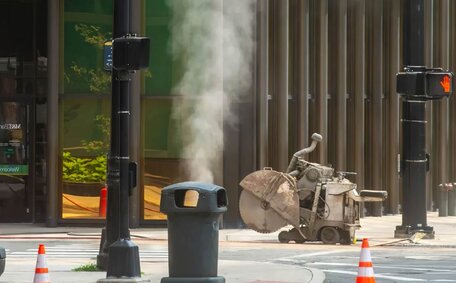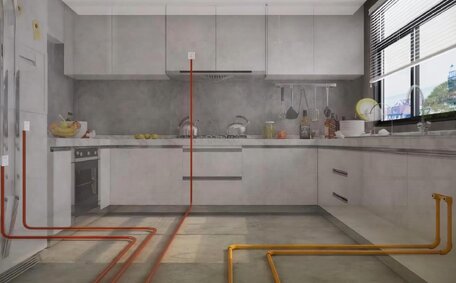
How To Move A Gas Meter
Need your gas meter relocated? You can’t move it yourself - contact your supplier to arrange for a gas engineer to reposition it safely. Charges may apply depending on circumstances.
Read MoreClogged drains are an extremely common issue that most homeowners will deal with at some point.
Whether it’s the kitchen sink backing up after washing dishes, the bathtub not draining properly, or the toilet overflowing, drain clogs can happen anywhere in the plumbing system. Whether it’s the kitchen sink backing up after washing dishes, the bathtub not draining properly, or the toilet overflowing, drain clogs can happen anywhere in the plumbing system.
Clogs tend to occur more frequently in kitchen and bathroom sinks, showers, and tubs where hair and soap scum accumulate over time. Drains can also get blocked further down the line by invasive root systems from trees and shrubs growing near underground pipes.
Kitchen drains often get clogged with food debris and grease from cooking activities. Kitchen drains often get clogged with food debris and grease from cooking activities.
Commercial plumbing systems experience drain clogs too, usually due to a high volume of use, and the types of materials going down the drains. For example, restaurants often deal with grease accumulation and food waste clogs. Hair salons struggle with tonnes of hair buildup stopping up their sinks and tubs.
No matter what type of drain is clogged, a plumbing snake or hydrojetting are two effective methods plumbers use to clear out the blockage and get things flowing freely again. Both options have their advantages and disadvantages depending on the location and severity of the clog.
A drain snake, also known as an auger or plumbing snake, is a long, flexible metal cable used by plumbers to mechanically clear clogs in drains and sewer lines. One end of the cable has a curved, corkscrew-shaped auger that works to break up blockages as it rotates and moves through the pipe.
The cable is wound around a drum and fed into pipes through drain openings.
Drain snakes come in different diameters and lengths to access clogs in various drains throughout a home or building. Larger machines with cables up to 100 feet long are used for main sewer lines. The auger end also varies, with some designed to drill through tough blockages like tree roots.
Smaller handheld snakes are ideal for sinks, showers and tubs.
When using a plumbing snake, the auger corkscrew tip latches onto the clog as the cable rotates and drives forward. This mechanical action breaks up the blockage in chunks small enough to pass through the pipes. A drain snake is an economical, low-tech solution used by plumbers for years to remove clogs and get drains functioning properly again.
The debris is cleared out as the cable retracts.
Using a drain snake to unclog pipes involves a straightforward process:
With expertise and the right equipment, plumbers can use a plumbing snake to grab, penetrate, and eliminate clogs without chemicals or disassembling pipes. It’s an economical and effective mechanical drain cleaning solution.
Drain snakes offer several benefits but also have some drawbacks:
Pros:
Cons:
Overall, drain snakes provide a relatively affordable mechanical option for clearing accessible clogs, but may not resolve severe or tricky blockages on their own.
Hydrojetting is a drain cleaning method that uses highly pressurised water to scour and clear out blockages in pipes and drains. It involves using specialised hydro jetting equipment that pumps water at extremely high pressures ranging from 1,500 to 5,000 PSI.
The pressurised water is fed through a hose and narrow nozzle to generate a targeted, powerful stream to blast through stubborn clogs. Hydrojetting can penetrate grease, soap buildup, sediment, sludge and other debris, propelling it along the pipe to dislodge and wash away the blockage.
Compared to manually snaking a drain, hydrojetting can access more pipes and remove clogs from further distances. The pressurised water can disintegrate and flush out the obstruction without damaging pipes in the process. Hydrojetting is an efficient way for plumbers to thoroughly clean the entire drain system and restore proper flow.
Hydrojetting to clear clogged drains follows a straightforward process:
With the right hydrojetting equipment and experienced technician, pressurised water can be precisely aimed to scour and clean the full length of pipes and drains, removing even the most difficult clogs.
Pros Cons
|
|
When it comes to clearing clogs, both drain snakes and hydrojetting have advantages and limitations that make them suitable for different scenarios.
Drain snakes provide a cost-effective solution for accessible clogs in smaller pipes like kitchen sinks and tubs. The mechanical auger action can physically break apart and pull out blockages that accumulate close to drain openings. However, snakes have difficulty reaching clogs further down the line or obstructions like tightly compacted debris or tree roots.
Hydrojetting uses pressurised water power to scour and flush the full length of pipes. The high water pressure effectively disintegrates tough clogs that snakes cannot penetrate on their own. However, hydrojetting requires large equipment and is less suitable for routine household clog removal in tight spaces.
For severe main drain clogs, a combination of both methods often works best. Drain snakes access and begin breaking up the mass, then hydrojetting finishes flushing out debris the snake loosened up. Together they can clear even the most severe obstructions.
Factors like pipe condition, clog location, available access, and cost also determine which method is preferred. Older or delicate pipes are prone to damage from high-pressure hydrojetting but can withstand gentler snaking. Exposed drains are easier to snake while buried pipes benefit more from hydrojetting.
With expert analysis of the specific drain and clog, plumbers determine whether to utilise hydrojetting, drain snakes, or both to clear blockages as quickly and effectively as possible.
Drain snakes tend to be the preferred method for clearing simple household clogs in sinks, tubs and toilets. Snaking works well for removing obstructions located near drain openings that result from the accumulation of hair, soap scum, food debris and other light material.
A handheld drain snake is the easiest solution for tackling minor clogs up to around 10 feet down the pipe. Compact sinks and tub drains with easy access points are well suited for snaking. Attempting to snake floor drains is more challenging.
Kitchen sink clogs caused by grease and food particles can often be cleared quickly by a standard sink plumbing snake. Likewise, bathtub drains blocked by hair and soap residue are easily removed with some manual auger action.
For toilets, a small closet auger is ideal for breaking up obstructions located in the toilet trap beneath the bowl. Typical toilet clogs result from too much toilet paper or other flushed items getting wedged in the toilet trap or main drainpipe.
Overall, drain snakes provide an accessible and cost-efficient solution for clearing simple household clogs before they escalate into major blockages requiring hydrojetting to remove.
Hydrojetting is the go-to solution for challenging clogs and blockages that drain snakes simply cannot handle on their own. Hydro jetting is preferred for clearing fully blocked pipes, removing obstructions located far down the line, and scouring away years of built-up debris.
Severely clogged kitchen drains from years of grease accumulation often require the intense scrubbing pressure of hydrojetting to fully clear. Tree root blockages that sneak in through cracks and wrap around pipes are no match for the cutting water power of a hydro jet.
Main sewer drain blockages that drain snakes just cannot reach can be opened up with hydro jetting. Longer access and more flexibility in pipe direction make hydro jetting the choice for buried backyard and basement drains.
Hydrojetting also excels at preventatively cleaning the entire length of drain and sewer pipes to wash away mineral deposits and debris buildup before it turns into a clog. Overall, any drain clogs that prove stubborn to drain snakes alone will likely benefit from upgrading to hydrojetting.
When it comes to drain cleaning, both drain snakes and hydrojetting can be tackled either professionally or as a DIY project, each with their pros and cons.
For DIY drain snaking, a handheld plumbing snake can be readily purchased from any hardware store at an affordable price.
With some instruction, homeowners can attempt clearing simple sink or tub clogs on their own. However, caution is needed to avoid damaging pipes or having sewage spill out. Dexterity and experience using the snake auger properly take practise.
Attempting to DIY hydrojetting is very difficult and not advisable. The intense water pressure can do serious damage in inexperienced hands.
Professional hydro jetting equipment costs thousands of dollars and requires specialised training to operate safely. Hydrojetting also involves discharging copious amounts dirty water that needs proper drainage planning.
The most thorough drain cleaning results will always come from hiring professional plumbers. They have specialised gear, expertise using it correctly, and take necessary safety precautions. For tough clogs, the combination of augering and hydro jetting together by a professional plumber offers the best chance of restoring full drainage function.
Drain snaking tends to have lower upfront costs compared to hydrojetting.
A basic handheld plumbing snake can be purchased for $20 to $60. Larger electric or drum snakes cost $250 or more. The equipment investment is relatively low but does require labour time and skill to operate.
In contrast, professional hydrojetting equipment costs from $5,000 for a small electric jetter to over $50,000 for high-end gas-powered trailer jetter units. However, the pressurised water can cut labour time significantly compared to manual snaking.
For residential jobs, simple snaking averages $150 to $350 per hour while hydrojetting averages $250 to $500. Hydrojetting carries added fees for large water volumes used and disposal.
For long sewer lines, snaking access fees add up quickly at $200 to $500 per line, while hydrojetting may run $500 to $1,500 depending on pipe length and complexity.
Though pricier, hydrojetting is extremely cost-effective for the time and thoroughness provided in resolving severe main line clogs that drain snakes cannot always fix alone.
Both drain snakes and hydrojetting offer effective methods for clearing clogged drains, with hydrojetting providing superior results for tough blockages. Drain snakes are affordable, accessible tools suitable for removing sink, tub and toilet clogs near drain openings.
However, they lack the power to penetrate severe clogs down the line. Hydrojetting’s high-pressure water can scour entire pipe systems and forcefully flush the most stubborn obstructions. While the equipment is expensive, the pressurised cleaning saves significant labour.
Factors like pipe condition, clog severity and location determine the best drain cleaning method. For optimal results, a combination of augering and hydrojetting together may be needed.
At the end of the day, calling professional plumbers like Menai Plumbing ensures accessing the proper equipment, expertise and experience to clear any clog and keep drains free flowing.
Need your gas meter relocated? You can’t move it yourself - contact your supplier to arrange for a gas engineer to reposition it safely. Charges may apply depending on circumstances.
Read MoreInvesting in a solar hot water system can save up to 75% on water heating costs. With great returns and added home value, solar hot water can be a smart choice over electric or gas heaters. Contact us to see if it’s the right investment for your home.
Read MoreWhile natural gas and propane can both power appliances in your home, they have notable differences when it comes to BTU output, infrastructure, safety, cost and more. Understanding these key contrasts will help you determine which is better for your specific needs.
Read MoreMenai, 2234 NSW
We will call back as soon as possible.




